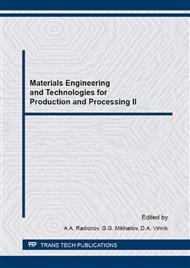[1]
D. Milicevic, Mycotoxins in the food chain – old problems and new solution, Tehn mesa. 50 (2009) 99-111.
Google Scholar
[2]
J.L. Richard, Some major mycotoxins and their mycotoxicoses -an overview, Int J Food Microbiol. 119 (2007) 3-10.
Google Scholar
[3]
H.S. Hussein, M.B. Jeffrey, Toxicity, metabolism, and impact of mycotoxins on humans and animals, Toxicol. 167 (2001) 101-104.
Google Scholar
[4]
F. Rossi, L. Rizzotti, G.E. Felis, S. Torriani, Horizontal gene transfer among microorganisms in food: current knowledge and future perspectives, Food Microbiology. 42 (2014) 232-243.
DOI: 10.1016/j.fm.2014.04.004
Google Scholar
[5]
C.S. Tibola, J.M.C. Fernandes, E.M. Guarienti, Effect of cleaning, sorting and milling processes in wheat mycotoxin content, Food Control. 60 (2016) 174-179.
DOI: 10.1016/j.foodcont.2015.07.031
Google Scholar
[6]
L.X. Wu, X.X. Ding, P.W. Li, X.H. Du, H.Y. Zhou, Y. Zh. Bai, L.X. Zhang, Aflatoxin contamination of peanuts at harvest in China from 2010 to 2013 and its relationship with climatic conditions, Food Control. 60 (2016) 117-123.
DOI: 10.1016/j.foodcont.2015.06.029
Google Scholar
[7]
P. López, D. Venema, T. Rijk, A. Kok, J. Scholten, H. Mol, M. Nijs, Occurrence of Alternaria toxins in food products in The Netherlands, Food Control. 60 (2016) 196-204.
DOI: 10.1016/j.foodcont.2015.07.032
Google Scholar
[8]
J. Luo, R.F. Vogel, L. Niessen, Rapid detection of aflatoxin producing fungi in food by real-time quantitative loop-mediated isothermal amplification, Food Microbiology. 44 (2014) 142-148.
DOI: 10.1016/j.fm.2014.06.004
Google Scholar
[9]
G. Perrone, M. Haidukowski, G. Stea, F. Epifani, R. Bandyopadhyay, J.F. Leslie, A. Logrieco, Population structure and Aflatoxin production by Aspergillus Sect, Flavi from maize in Nigeria and Ghana, Food Microbiology. 41 (2014) 52-59.
DOI: 10.1016/j.fm.2013.12.005
Google Scholar
[10]
R. Gupta, S. Srivastava, Antifungal effect of antimicrobial peptides (AMPs LR14) derived from Lactobacillus plantarum strain LR/14 and their applications in prevention of grain spoilage, Food Microbiology. 42 (2014) 1-7.
DOI: 10.1016/j.fm.2014.02.005
Google Scholar
[11]
M. Benlloch-Tinoco, M. Igual, D. Rodrigo, N. Martínez-Navarrete, Superiority of microwaves over conventional heating to preserve shelf-life and quality of kiwifruit puree, Food Control. 50 (2015) 620-629.
DOI: 10.1016/j.foodcont.2014.10.006
Google Scholar
[12]
Y.I. Kretova, Y.I. Zdanovich, G.I. Cuglenok, N.V. Cuglenok, RU Patent 2, 283, 861. (2005).
Google Scholar
[13]
E.I. Cherkasova, Y.I. Kretova, Y. I. Zdanovich, G.I. Cuglenok, N.V. Cuglenok, G.G. Usenova, RU Patent 2, 292, 164. (2005).
Google Scholar
[14]
Y.I. Kretova, I.Y. Potoroko, RU Patent 2, 562, 152. (2015).
Google Scholar
[15]
J. Gil-Serna, B. Patiño, L. Cortes, M.T. Gonzalez-Jaen, C. Vazquez, Aspergillus steynii and Aspergillus westerdijkiae as potential risk of OTA contamination in food products in warm climates, Food Microbiology. 46 (2015) 168-175.
DOI: 10.1016/j.fm.2014.07.013
Google Scholar
[16]
S. Choi, H. Jun, J. Bang, S. -H. Chung, Y. Kim, B. Kim, H. Kim, L.R. Beuchat, J. -H. Ryu, Behaviour of Aspergillus flavus and Fusarium graminearum on rice as affected by degree of milling, temperature, and relative humidity during storage, Food Microbiology. 46 (2015).
DOI: 10.1016/j.fm.2014.08.019
Google Scholar
[17]
S. Kalai, M. Bensoussan, P. Dantigny, Lag time for germination of Penicillium chrysogenum conidia is induced by temperature shifts, Food Microbiology. 42 (2014) 149-153.
DOI: 10.1016/j.fm.2014.03.016
Google Scholar
[18]
E.P. Zarubin, S.F. Danko, T.N. Danilchuk, the Influence of frequency of alternating current on solidarista barley, Beer and drinks. 4 (2003) 14-15.
Google Scholar
[19]
K.V. Puchkov, Application elettromagnetico field of ultrahigh frequency in food processing industry, Bulletin of the Council. (2002) 40-41.
Google Scholar
[20]
L.S. Lvova, O.N. Kislenko, The problems of ecological safety of grain, Cereals. 5 (2004) 38-41.
Google Scholar


